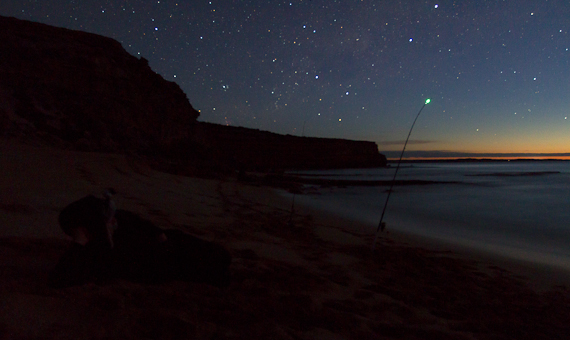 |
| Starry Seascape |
The Night Time Fun Continues
Shooting at night with only the moon and stars as a light source is certainly fun, and a challenge. As mentioned in part 1, this was all experimental for me. Essentially I played around with shutter speeds, apertures, and focusing and simply reviewed the results on my cameras LCD screen. I made adjustments based on what I could see. Being so dark, I basicallty relied on wider apertures ranging from f1.4 -2.8 on my 50mm lens, and with my wide angle zoom unfortunately I was limited by the maximum aperture of f4. Essentially I shot almost every shot at 30 seconds no matter the aperture as this was the longest available on my camera without using a remote shutter or cable release which I didn't have with me. To adjust for the different apertures I varied the ISO settings between ISO 1600 and ISO 6400. It may be a little disappointing to read after the long wait for part 2, but that is essentially it. Use a wide aperture, a slow shutter speed, and the lowest ISO setting that allows enough light to capture the image you are after. To be honest, the experimentation is quite rewarding in itself. On some shots I also used the in camera noise reduction which helped a little, however it essentially doubles the length of the exposure. The process reminds me of developing film in a darkroom. Immediately after each image is captured, you sit and wait for the capture to end, and then an image emerges on the LCD. Ok, not quite the same, but when you are starting out what you get can be quite a mystery until you see it.
One other variable that you can play with in camera or later on the computer if you shoot in RAW as I do is the white balance. As you can see below, a different white balance setting is used in an image similar to the one at the top of the post which entirely changes the mood.
 |
| White balance can make a big difference |
 |
| Another Idea is to shoot as the stars are appearing right after the sun goes down. |
Of course if you want to take things further you can experiment in mixing flash or other artificial light sources with these types of shots. As you will see from the few examples below, I have a lot of work to do in this department. It requires a lot of thought. In particular about what will be behind the flash lit subject if it's human, as during the remaining part of the exposure they will no doubt move to some extent. Gives me a lot to think about next time anyway. Hope you have found these images interesting.
 |
| From memory it was only a headlamp providing the artificial lighting in this shot |
 |
Note the fishing rod behing his head! Canon 580EXII off camera provided the illumination
|





